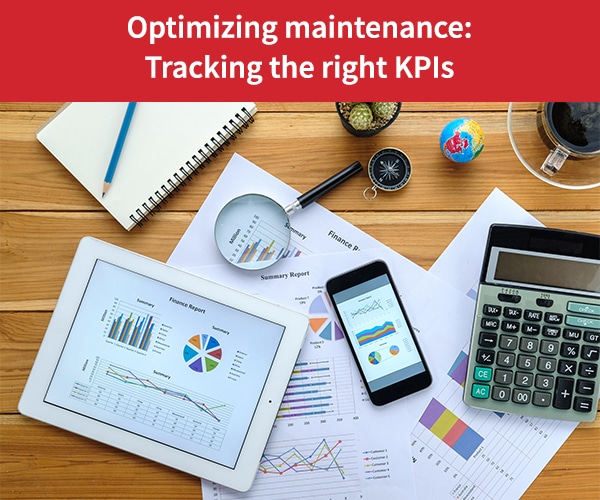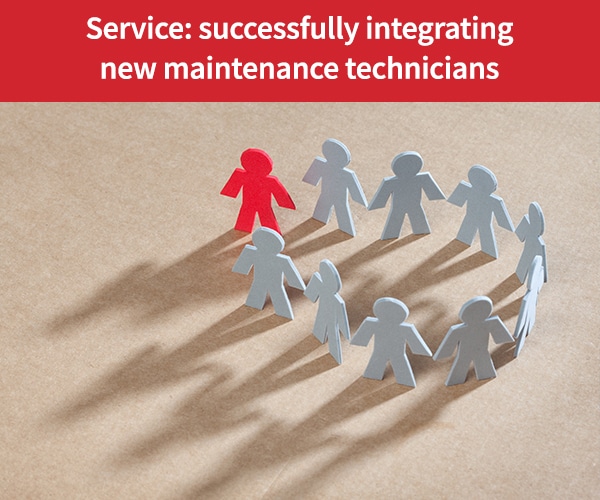
- Analytics
- Maintenance
Tracking the Right KPIs to optimize maintenance
Breakdowns and downtime affect the productivity and efficiency of almost every business activity. The bigger the business, and the more complex its infrastructure, the more ripple effects there are when a device or system fails.
Today, new technologies such as connected objects make it possible to continuously “talk” to equipment, and to set up preventive maintenance, and even predictive maintenance, processes. Now, maintenance technicians can analyze the data sent by each connected device and step in to address issues before equipment fails. While the technology is not yet widely deployed, the role of “smart” equipment grows every day.
With this new way of working, maintenance companies can implement service processes that are more fully integrated with their customers’ processes to reduce the impact of maintenance activities on production volumes and company operations.
The Internet of Things and data analysis become the framework for managing maintenance activities
Field service management software allows maintenance companies to create more accurate and efficient service schedules. The advent and growth of new technologies such as the Internet of Things (IoT) and data analysis based on “big data” allows maintenance companies to evolve from offering passive, corrective maintenance to offering new forms of proactive maintenance.
Smart, talkative equipment
With proactive maintenance, service technicians can use probability calculations that are based on analysis of the continual stream of data transmitted by connected equipment to step in just before failures occur.
The emergence of cloud technology helps to advance new forms of maintenance by enabling large volumes of data to be easily stored in the cloud and used in algorithmic calculations. These calculations can identify trends and determine the likelihood of failures on each type of equipment. What seemed like science fiction a few years ago is now part of the professional landscape for maintenance companies.
Rapid IoT development in maintenance
New service models are quickly gaining traction because everyone wins:
-
Maintenance companies can evolve to more precise and profitable operations centered around fully justified actions
-
Their customers experience fewer operational obstructions and slowdowns due to untimely equipment breakdowns
-
You can bet that in the next 10 years, the numbers of connected equipment will explode and almost all maintenance companies will be equipped with field service management software and the technologies
-
needed to manage preventive, even predictive, maintenance operations.
Key performance indicators to optimize maintenance
As maintenance companies move to take advantage of technology innovations, they’ll have to quickly develop a set of key performance indicators that allows them to track the ongoing operation of the equipment in each of their customers’ fleets. After all, each customer dreams of equipment fleets that operate for their maximum lifespan with minimal repair, maintenance or upgrade costs.
With connected equipment and the ability to intelligently analyze the huge volumes of data that’s generated, maintenance companies can track key performance indicators (KPIs) that allow them to manage their activities in faster and more precise ways
Here are a few KPIs worth tracking:
Average recovery time
This is the average recovery time after an equipment failure. This KPI tells maintenance companies the average amount of time needed to detect and isolate a fault, and to replace the defective part. It’s typically used to determine the overall availability of equipment so the goal is to have the lowest possible value for this KPI.
Average failure time
The average failure time is the time required to repair faulty equipment after a failure. Unlike the average recovery time, the average failure time includes the entire duration of repair and maintenance operations as well as delays due to slow parts deliveries, parts replacement times and unsuccessful attempts to execute the repair outside of scheduled maintenance activities. Because equipment is not operational during the average failure time, this KPI should also have the lowest possible value.
Overall equipment efficiency
The overall equipment efficiency KPI identifies trends related to the productivity and value added by a particular piece of equipment or a fleet of equipment. It also identifies unexpected productivity drops and value losses when equipment is operational and there are no scheduled stoppages such as planned maintenance periods or weekend shutdowns.
The key factors to consider when calculating overall equipment efficiency are availability, service and quality. As a result, this KPI must be tailored for each customer’s business and operations as it is difficult to establish generic levels and thresholds that make sense for all companies.
Identifying the essential indicators for your maintenance operations
KPIs are becoming increasingly important in business management as well as in technical and maintenance industries because they reveal numerous opportunities to improve performance. And it’s all made possible by recent advances in data analysis.
By tracking the right KPIs, maintenance companies can identify areas where they have the potential to improve the productivity and efficiency of maintenance processes as well as areas where they have the potential to reduce the operating costs for a company’s technical equipment.
Every business owner should be turning their full attention to KPIs.
Maintenance companies and their customers can find more information on KPIs in European standards such as DIN EN 15341 (on performance indicators for maintenance) or DIN 31051 (on the principles of maintenance).
Our similar articles.
-
- Maintenance
- Technician
- Recruiting
- Recrutement
How to successfully integrate new maintenance technicians
October 21, 2020 -
- Maintenance
- Field Service Management
- Technician
- Work orders
What statistics tell us about the future of field service management
August 27, 2018 -
- Secteurs d'activité
- Maintenance
- Technician
- After-sales service
- Work orders
Maintenance challenges in the retail industry
June 19, 2019


